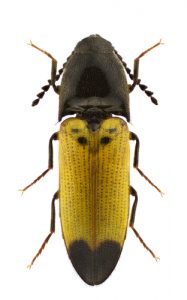Click Beetles Are Attracted to Lights
By Chris Williams on May 3, 2012.
Q. We have this very strange bug that keeps getting into our house. It looks like a brown beetle, about ½ inch long, but it jumps and makes this snapping sound. I often find them in the bathroom in the morning but sometimes in other rooms. Do you know what it’s feeding on?
A. I think your nighttime visitor is probably a click beetle. It’s not feeding on anything in your house. It’s only in your house because it was attracted to lights. I’m betting that you keep a nightlight on in the bathroom and that maybe there is a window or door that is not tightly sealed.
 As you can guess, click beetles are named for the noise they make when they flip themselves into the air in order to right themselves again. As if the flip wasn’t startling enough, it is accompanied by an audible snap or click sound, like someone had snapped their fingers. The beetles apparently “click” and flip to turn themselves over when they end up on their backs. They will also click if you pick them up or disturb them, probably as a defense mechanism. The process begins when the beetle arches its back and uses a spine and groove mechanism underneath its thorax to project itself into the air, hopefully landing right side up some distance away. They will keep repeating the clicking process until they do land upright again.
As you can guess, click beetles are named for the noise they make when they flip themselves into the air in order to right themselves again. As if the flip wasn’t startling enough, it is accompanied by an audible snap or click sound, like someone had snapped their fingers. The beetles apparently “click” and flip to turn themselves over when they end up on their backs. They will also click if you pick them up or disturb them, probably as a defense mechanism. The process begins when the beetle arches its back and uses a spine and groove mechanism underneath its thorax to project itself into the air, hopefully landing right side up some distance away. They will keep repeating the clicking process until they do land upright again.
Once, in Arizona, I had a guide who had never noticed click beetles before. I made some that came to the camp light perform. He immediately christened them “break-backs” and began to count up how much he would win, after he got back to Tucson, by betting on ‘whether they would or wouldn’t land right side up.’ I advised him to put his money on ‘would’ and for nights thereafter he hung around my moth tent, turning (them) on their backs to see whether they would or wouldn’t. I do not know how he made out. –Frank Lutz, author of Field Book of Insects, published 1918.
The most common click beetles that get into homes are flattened, elongate, about ½ inch long and plain brown. Their bodies taper at each end and could be described as “boat-shaped.” There is also a more impressive eyed click beetle that has two large “eyespots” on its back just behind the head, another way to scare away predators. The larval forms of click beetles are called wireworms because they are long and wormlike and have a brownish-yellow hardened outer shell. Some are predators and are found under rotting logs, under tree bark, or under mulch along building foundations. Others are plant pests and are found in soil around newly planted crops, garden plants, or grasses where they feed on the roots.
Although click beetles can startle you when they unexpectedly click, they do not bite or sting and they don’t do any damage in the home. Kids and pets like to play with them.
The best control for click beetles is to reduce outdoor lighting that attracts them to your house, for example porch and yard lights. Turning all lights off when you go to bed will help, too. Also screen and caulk any openings that they are using to get inside. Check that bathroom window screen. If you really have a lot of click beetles around outside doorways, a pest control company can apply a barrier pesticide treatment. When click beetle larvae (wireworms) are abundant in lawns, the homeowner may need a lawn pesticide treatment.